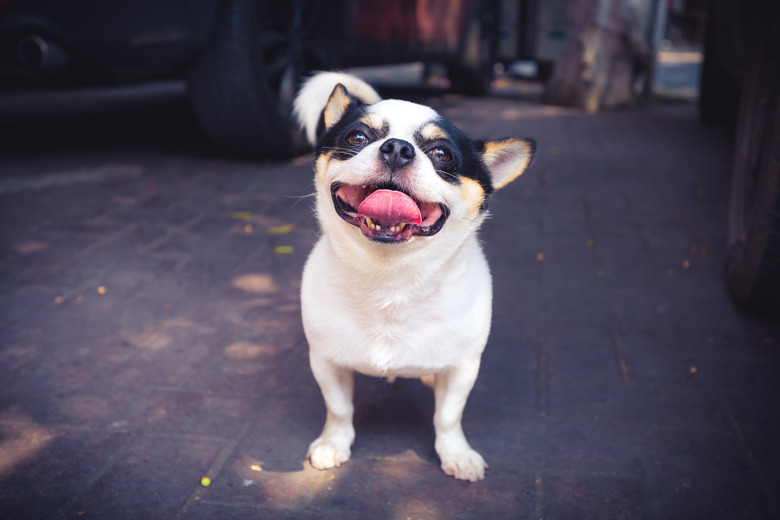What To Know About Dogs In Heat
If you have a female dog who you have not yet spayed, then it's important to understand how her estrus cycle affects her — not only for the health of your best friend, but also because unwanted pregnancies can increase the homeless pet population.
Cuteness is an advocate for spaying female dogs, as well as adopting homeless pets.
How much do female dogs bleed when they're in heat?
How much do female dogs bleed when they're in heat?
While the amount of bleeding varies depending on age, genetics and health, most breeds will experience some form of discharge, blood or otherwise, for as few as 2 days to as many as 22 days. Females have the potential to bleed during the entirety of the first two stages of their four-stage estrus (heat) cycle.
Proestrus is the first stage where levels of the sex hormone estrogen increase causing behavioral and physical changes in female dogs. Blood vessels in the womb enlarge and vaginal discharge occurs. The amount of discharge varies with some females only spotting, while others bleed heavily.
How long does the bleeding phase last for dogs in heat?
How long does the bleeding phase last for dogs in heat?
The bleeding phase of a dog's estrus cycle usually happen during the proestrus and estrus stages of the estrus cycle, which usually lasts a combined 18-22 days. The average cycle for a female dog happens about once every six months between January and March and again between August and October.
How long is a dog's menstrual cycle?
How long is a dog's menstrual cycle?
The length of a dog's estrus cycle will vary on age, genetics, breed and health, but it's typically 18-28 days. For most of the year, an un-spayed female is in the anestrus (resting) stage of her estrus cycle. But for 2-4 weeks of the season, she will be in heat.
Dogs' estrus cycles are comprised of four stages: proestrus, estrus, diestrus and anestrus.
Proestrus: The initial 9-11 days of the estrus cycle begins with physical and behavioral changes. Un-spayed females may begin to vaginally discharge and their vulvas typically swell and change color.
Estrus: This is often referred to as "being in heat," and it's the period 9-11 days when an un-spayed female is receptive to mating. The vaginal discharge will tinge pink, turn clear and then soon cease.
Diestrus: Whether the un-spayed female mates or not, she'll enter a 60-day diestrus stage. Pregnant dogs will give birth at the end of this period, and dogs who are not pregnant may display signs of false pregnancy or simply transition to the next stage.
Anestrus: The final rest and recovery stage that allows females to prepare for their next estrus cycle.
What are the signs of a female dog in heat?
What are the signs of a female dog in heat?
If you have a female dog who has not been spayed, then you definitely need to know the signs that your dog is in heat. Canine estrus occurs twice a year for most dogs — with toy breed and large breeds being outliers who experience cycles more and less frequently. Typically estrus happens in the spring and fall.
- Increased pheromone production
- Vaginal discharge that may be red, pinkish, clear or a brackish brown color
- Swollen vulva
- Vulva may change in color to a vibrant pink or a bright red
- Licking the genital area
- Mounting behavior
- More frequent urination
- Sudden behavioral changes
Can dogs get pregnant if they've never had a period?
Can dogs get pregnant if they've never had a period?
An un-spayed dog cannot get pregnant if she has not had her estrus cycle, which is commonly and inaccurately referred to as a "period." A dog is only fertile during the first two stages of her estrus cycle, which lasts for about 22 days and typically occurs only twice a year. Though some small and large breeds have four cycles a year or only one cycle every 18 months.
Some dogs will show signs of pregnancy without being pregnant. Veterinarians call this false pregnancy or pseudopregnancy, and it's thought to be caused by a hormonal imbalance. Signs of psuedopregnancy include:
- Enlargement of the mammary glands
- Lactation
- Abdominal distention
- Behavioral changes like nesting or depression
- Vomiting
- Loss of appetite
Your veterinarian can help diagnose and treat false pregnancy. But unless symptoms persist, treatment is typically unnecessary.
Can dogs get pregnant the first time they mate?
Can dogs get pregnant the first time they mate?
There are many old farmers' tales about when female dogs will get pregnant. Among them is the idea that a dog cannot get pregnant the first time she mates, which is simply not true. Both male and female dogs are able to reproduce once they reach puberty.
While it varies by breed, most dogs will reach sexual maturity between 6-18 months of age. Female dogs are most fertile about 10 days into their cycle when the bleeding stops and their discharge turns clear. Peak fertility lasts an average of five days, but a dog can get pregnant all through her proestrus and estrus cycle (approximately 18-22 days).
How long after pregnancy will a dog get her period?
How long after pregnancy will a dog get her period?
While dogs do not have periods — at least, not a period as humans define it — un-spayed females will go into a reproductive estrus cycle twice a year. Having a litter will typically not alter the timing of a dog's estrus cycle more than a month or so, if at all. Though, it depends on the breed and size of the dog.
Professional breeders recommend that a female dog should be allowed at least one cycle to pass between litters for the benefit of the mother.
Can a spayed dog still go into heat?
Can a spayed dog still go into heat?
Female dogs in heat undergo a variety of uncomfortable physical and behavioral changes. Spaying is regarded as a healthy, practical solution not only for these issues, but also the host of maladies that occur for un-spayed domestic dogs. But will spayed dogs still go into heat?
Spaying removes both the ovaries and the uterus of a female dog, and the process should put an end to a dog's estrus cycles. The ovaries produce sex hormones, particularly estrogen, which trigger estrus. With the ovaries removed, the hormones will no longer be produced, and the heat cycles will come to an end.
If a spayed dog displays symptoms of similar to those of estrus — such as swelling of the vulva or discharge — then your best friend may be suffering from ovarian remnant syndrome, which is caused by bits of ovarian tissue left behind during the spay surgery. This tissue can still release hormones and cause a spayed dog to still go into heat.
Conclusion
Conclusion
Female dogs go through significant physical and behavioral changes during the four stages of their estrus cycle. If you have an un-spayed female, then it's vitally important that you understand how estrus affects your best friend.
If your female dog shows signs of pregnancy or heat, but she is experiencing neither, speak to a veterinarian about the possibility of a pseudopregnancy or ovarian remnant syndrome.
Always check with your veterinarian before changing your pet's diet, medication, or physical activity routines. This information is not a substitute for a vet's opinion.




